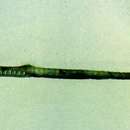Diagnostic Description
provided by Fishbase
Short-snouted species with large eyes (Ref. 48635).Description: Characterized by mottled brown color, usually with greyish saddles across dorsum and whitish blotches on side; 10 caudal rays; ring 17 - 18 + 32 - 37; discontinuous superior trunk and tail ridges; inferior trunk ridge ending at anal ring; lateral trunk ridge confluent with inferior tail ridge; length of snout 2.0-2.6 in head length; depth of snout 3.3-5.3 in snout length; head length 7.7-10.9 in SL (Ref. 90102).
Life Cycle
provided by Fishbase
Males carry the eggs in the brood pouch (Ref. 205).
Morphology
provided by Fishbase
Dorsal soft rays (total): 19 - 22; Analsoft rays: 4
Trophic Strategy
provided by Fishbase
Found on the continental shelf (Ref. 75154). Both larval and adult forms occur in mangroves (Ref. 43081).
Biology
provided by Fishbase
Adults live in muddy habitats, often covered with silt and extremely well-camouflaged (Ref. 48635). Planktonic specimens taken in the upper 0 to 100 m over depths to at least 2980 m while the demersal fish have been taken in SCUBA and trawl collections from 9 to 91.4 m. Ovoviviparous (Ref. 205). Males exhibit parental care by incubating and guarding the eggs in their brood pouch (Ref. 43081).
- Recorder
- Estelita Emily Capuli
分布
provided by The Fish Database of Taiwan
分布於印度-西太平洋海域,西起斯里蘭卡、泰國灣等,北至日本,南至澳洲等附近海域。臺灣分布於南部、東北部及小琉球海域等。
利用
provided by The Fish Database of Taiwan
小型魚類,偶為潛水或網具捕獲,除學術研究及水族觀賞外,不具食用價值。
描述
provided by The Fish Database of Taiwan
體特別的延長和纖細,無鱗,由一系列的骨環所組成;軀幹部的上側稜與尾部上側稜不相連接,下側稜則止於臀部骨環附近而不與尾部相接,中側稜則與尾部下側稜相接;體環緣邊均細棘齒;背鰭基底下方之體環背部隆起。吻短;吻部背中稜完全,具棘及小刺,側吻棘存在。主鰓蓋具一完全的中縱稜,略向上彎曲,上有一棘。體環無弱縱棘;具皮瓣。骨環
17-18 + 32-37;背鰭鰭條數
19-22;胸鰭鰭條數15-20;尾鰭鰭條數
10。體褐色,體側具12-14不顯之暗色橫斑帶;通常在第12-13體環間具一暗色斑塊;鰓蓋及鰓膜經常具淡色班帶或斑塊。
棲地
provided by The Fish Database of Taiwan
主要棲息於污泥底質的海域,通常出現於河口沙洲及隱飾高的水域,棲息深度在0-100公尺深。
Halicampus grayi
provided by wikipedia EN
Gray's pipefish, also known as the mud pipefish or spiny pipefish (Halicampus grayi) is a species of marine fish of the family Syngnathidae.[3] It is found in the Indo-Pacific in the Gulf of Aden, Sri Lanka, and from the Gulf of Thailand to Japan, the Marshall Islands, and the Great Barrier Reef. It lives to depth of 100 metres (330 ft), and planktonic juveniles have been found above depths of 3,000 metres (1.9 mi).[1] It occurs in muddy habitats, in estuaries, and on coral reefs, where it likely feeds on small crustaceans. It can grow to lengths of 20 centimetres (7.9 in). This species is ovoviviparous, with males carrying eggs in a brood pouch before giving birth to live young.[1]
Etymology
The fish's patronym was not identified but it was certainly in honor of British zoologist John Edward Gray (1800-1875), who got Kaup's monograph on syngnathid fishes published under the auspices of the British Museum.[4]
Description
H. grayi is brownish with dark bars along the side of its body, and pale bars on the gill membrane. This colouring provides extremely good camouflage for muddy and silty habitats, where the species will cover itself to stay hidden.[5]
References
-
^ a b c Kuo, T. & Pollom, R. (2016). "Halicampus grayi". The IUCN Red List of Threatened Species. 2016: e.T65367590A67624487. doi:10.2305/IUCN.UK.2016-1.RLTS.T65367590A67624487.en.
-
^ Froese, Rainer; Pauly, Daniel (eds.) (2018). "Halicampus grayi" in FishBase. February 2018 version.
-
^ Dawson, C.E., 1985. Indo-Pacific pipefishes (Red Sea to the Americas). The Gulf Coast Research Laboratory Ocean Springs, Mississippi, USA
-
^ Christopher Scharpf & Kenneth J. Lazara (22 September 2018). "Order SYNGNATHIFORMES: Families AULOSTOMIDAE, CENTRISCIDAE, FISTULARIIDAE, SOLENOSTOMIDAE and SYNGNATHIDAE". The ETYFish Project Fish Name Etymology Database. Christopher Scharpf and Kenneth J. Lazara. Retrieved 9 December 2021.
-
^ Thompson, Vanessa J. & Dianne J. Bray, Halicampus grayi in Fishes of Australia, accessed 10 Jan 2018, http://fishesofaustralia.net.au/home/species/1528

- license
- cc-by-sa-3.0
- copyright
- Wikipedia authors and editors
Halicampus grayi: Brief Summary
provided by wikipedia EN
Gray's pipefish, also known as the mud pipefish or spiny pipefish (Halicampus grayi) is a species of marine fish of the family Syngnathidae. It is found in the Indo-Pacific in the Gulf of Aden, Sri Lanka, and from the Gulf of Thailand to Japan, the Marshall Islands, and the Great Barrier Reef. It lives to depth of 100 metres (330 ft), and planktonic juveniles have been found above depths of 3,000 metres (1.9 mi). It occurs in muddy habitats, in estuaries, and on coral reefs, where it likely feeds on small crustaceans. It can grow to lengths of 20 centimetres (7.9 in). This species is ovoviviparous, with males carrying eggs in a brood pouch before giving birth to live young.
- license
- cc-by-sa-3.0
- copyright
- Wikipedia authors and editors

